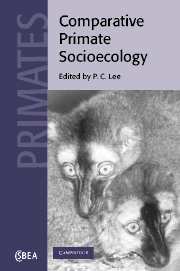Book contents
- Frontmatter
- Contents
- List of contributors
- Preface
- Part 1 Comparative methods
- Part 2 Comparative life history and biology
- 4 Socioecology and the evolution of primate reproductive rates
- 5 Comparative ecology of postnatal growth and weaning among haplorhine primates
- 6 Some current ideas about the evolution of the human life history
- 7 The evolutionary ecology of the primate brain
- 8 Sex and social evolution in primates
- 9 Mating systems, intrasexual competition and sexual dimorphism in primates
- Part 3 Comparative socioecology and social evolution
- Editor's conclusion: Socioecology and social evolution
- Index
5 - Comparative ecology of postnatal growth and weaning among haplorhine primates
Published online by Cambridge University Press: 24 August 2009
- Frontmatter
- Contents
- List of contributors
- Preface
- Part 1 Comparative methods
- Part 2 Comparative life history and biology
- 4 Socioecology and the evolution of primate reproductive rates
- 5 Comparative ecology of postnatal growth and weaning among haplorhine primates
- 6 Some current ideas about the evolution of the human life history
- 7 The evolutionary ecology of the primate brain
- 8 Sex and social evolution in primates
- 9 Mating systems, intrasexual competition and sexual dimorphism in primates
- Part 3 Comparative socioecology and social evolution
- Editor's conclusion: Socioecology and social evolution
- Index
Summary
Introduction
Why are the problems of growth interesting? Somatic growth relates to individual survival; growth failure or faltering is associated with an increased likelihood of mortality (rhesus: Small and Smith, 1986; humans: Skuse et al., 1995), and weight for age can be used as a proxy for morbidity or mortality risks (humans: Tomkins, 1994). Maternal mass and body composition can influence reproductive potential and efficiency in terms of fetal growth and lactation capacity (Martin, 1984; Lee and Bowman, 1995). Growth is also a variable with a time component and as such it links with a suite of life history traits within a species, and has been used to describe variation in the timing of events within a life history strategy (Harvey, Clutton-Brock and Martin, 1987; Ross, 1988; Lee, 1996). Growth thus raises two distinct questions in primate comparative biology. The first concerns the underlying selected mechanisms for attaining metabolic and reproductive efficiencies. The second concerns whether and how such growth strategies are achieved at the population or individual level.
Growth can be partitioned into separate periods, each with possibly independent rates and trajectories, as well as unique problems to be solved. These distinct periods may have repercussions on subsequent growth stages, as well as an influence on behaviour and reproductive ability (Bercovitch, 1987; Altmann, 1991). The three major periods are fetal growth, postnatal growth during the period of lactation, and finally growth between weaning and the attainment of a terminal mass or stature, often associated with the onset of reproduction among females (see Leigh, 1994a; Leigh and Shea, 1996).
- Type
- Chapter
- Information
- Comparative Primate Socioecology , pp. 111 - 139Publisher: Cambridge University PressPrint publication year: 1999
- 35
- Cited by



